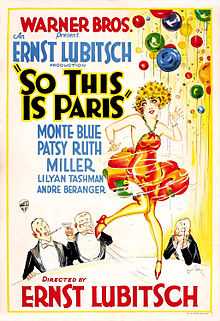So This Is Paris (1926 film)
| So This Is Paris | |
|---|---|
 Film poster | |
| Directed by | Ernst Lubitsch |
| Produced by | Warner Brothers |
| Written by |
Henri Meilhac (play: Reveillon) Ludovic Halévy (play: Reveillon) Hans Kraly (scenario) |
| Starring |
Monte Blue Patsy Ruth Miller Lilyan Tashman |
| Cinematography | John J. Mescall |
| Distributed by | Warner Bros. |
Release dates |
|
Running time | 7 reels / 186,995 centimetres (6,135.01 ft) |
| Country | United States |
| Language | Silent film (English intertitles) |
So This is Paris is a 1926 American silent comedy film produced and distributed by Warner Brothers and directed by Ernst Lubitsch. The film is based on an old stage play Reveillon by Henri Meilhac and Ludovic Halevy. It stars Monte Blue and Patsy Ruth Miller. Preserved at the Library of Congress and the Turner Entertainment Company.[1]
Plot
Paul Giraud is happily married to Suzanna, and together they live in a quiet neighborhood. As Suzanna notices that their new neighbors are expressive dancers with revealing outfits, she demands Paul to complain to them about their lack of morality. As Paul knocks on his neighbors' door, he finds out that the woman is an old flame, Georgette Lalle. They reunite happily, and Georgette even attempts to kiss Paul, despite being married to her jealous husband Maurice. Paul does not answer Georgette's displays of affection, and instead introduces himself to Maurice. Back at home, Paul lies about his meeting with the Lalle's, which confuses Suzanna as Maurice comes over moments later, trying to win her affection and expressing Paul's kindness. Paul overhears their flirtatious conversation, but pretends to be asleep.
Somewhat later, Paul is on his way for a secret meeting with Georgette, when he is suddenly stopped by a police officer for speeding. After insulting the officer, Paul is charged with three days in prison. Suzanna, under the impression that Paul was speeding due to a patient crisis, does not understand why Paul does not gather witnesses to prove that he was speeding because of an emergency. She decides to call up the patient on the phone herself, only to find out that he is dead. Paul goes out to celebrate his death at the Artists Ball with Georgette. As he dresses up for a night out, he convinces Suzanna that he is heading to jail to serve his three-day sentence.
While Paul and Georgette are enjoying themselves at a wild party, where they are dancing the Charleston, Maurice visits Suzanna and they grow intimate. They are caught by a detective, who is at the mansion to arrest Paul. Fearing a scandal, Suzanna convinces Maurice to pose as her husband, and he unhappily allows himself to be escorted by the detective. Meanwhile, she overhears through the radio that Paul and Georgette are the winners of a Charleston contest at the Artists Ball. She dresses up and comes over to confront her drunken husband, and tells him that he should be grateful to her for not having to go to jail anymore. They eventually reunite.
Cast
- Monte Blue - Doctor Paul Giraud
- Patsy Ruth Miller - Suzanna Giraud
- Lilyan Tashman - Georgette Lalle
- Andre Beranger - Maurice Lalle
- Dot Farley - Madame Moreau
- Myrna Loy - The Maid
- Sidney D'Albrook - The Policeman
- Max Barwyn - The Detective
Reception
The film received positive reviews, and was voted by The New York Times as one of the ten best films of 1926. The critic for the newspaper wrote that "in So This Is Paris, [Lubitsch's] tour de force is an extraordinarily brilliant conception of an eye full of a Charleston contest, with vibrant kaleidoscopic changes from feet and figures to the omnipotent saxophones. [..] The comedy in this film had, up to that time, kept the audience in constant explosions of laughter, but the startling dissolving scenic effects and varied "shots" elicited a hearty round of applause."[2]
References
- ↑ So This is Paris at silentera.com
- ↑ Review of So This is Paris The New York Times, August 16, 1926.